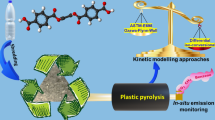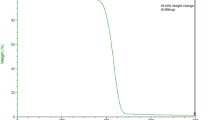Abstract
The increase of the plastic wastes has urged finding different solutions for their recycling. Thermal pyrolysis is a suitable solution for refining the combination of different plastics. The main goal of this research is developing a model to predict the distribution of products obtained from pyrolysis. To do this a mechanism model based on free radical mechanism is developed. In this model some kinetic stages are used including initiation, scission, abstraction, aromatic making and radical combination. After determining the kinetic constants, the equations were solved in MATLAB software. The results were compared with experimental results from a conical spouted bed reactor (CSBR) in temperature (500–900 °C) and residence time (0.016–0.032 s). the results show that the model can predict the experimental observation for different temperatures and residence time and estimate the amount of low and high density products in a way that the increase of that gas fraction increase and high density products decrease. Also in all the situation the amount of olefin fraction is more than paraffin and diolefin.








Similar content being viewed by others
Abbreviations
- Arn :
-
molar flow of n carbon atoms aromatic (mol/m3)
- Dn :
-
molar flow of n carbon atoms diolefin (mol/m3)
- Kf :
-
kinetic constant of H-abstraction reaction (m3/mol s)
- Kpp :
-
kinetic constant of initial scission reaction (s− 1)
- Kr :
-
kinetic constant of H-abstraction reaction (m3/mol s)
- Kt :
-
kinetic constant of termination reaction (m3/mol s)
- K1ar :
-
kinetic constant of production of aromatics 1reaction (m3/mol s)
- K2ar :
-
kinetic constant of production of aromatics 2reaction (m3/mol s)
- Kβ :
-
kinetic constant of β-scission reaction (s− 1)
- On :
-
molar flow of n carbon atoms olefin (mol/m3)
- Pn :
-
molar flow of n carbon atoms paraffin (mol/m3)
- riβ :
-
rate of production of i via β-scission (mol/m3 s)
- riArn :
-
rate of production of i via aromatization (mol/m3 s)
- rif :
-
rate of production of i via H-abstraction (mol/m3 s)
- ripp :
-
rate of production of i via initial scission (mol/m3 s)
- rir :
-
rate of production of i via H-abstraction (mol/m3 s)
- rit :
-
rate of production of i via termination (mol/m3 s)
- rj :
-
rate of production of the j reaction (kg/m3 s)
- RDn :
-
molar flow of n carbon atoms radical diolefin (mol/m3)
- ROn :
-
molar flow of n carbon atoms radical olefin (mol/m3)
- RPn :
-
molar flow of n carbon atoms radical paraffin (mol/m3)
References
Al-Salem S, Lettieri P (2010) Kinetic study of high density polyethylene (HDPE) pyrolysis. Chemical engineering research design 88(12):1599–1606
Artetxe M et al (2012) Production of light olefins from polyethylene in a two-step process: pyrolysis in a conical spouted bed and downstream high-temperature thermal cracking. Ind Eng Chem Res 51(43):13915–13923
Biswas S, Mohanty P, Sharma D (2013) Studies on synergism in the cracking and co-cracking of Jatropha oil, vacuum residue and high density polyethylene: kinetic analysis. Fuel Process Technol 106:673–683
Bockhorn H, Hentschel J, Hornung A, Hornung U (1999a) Environmental engineering: stepwise pyrolysis of plastic waste. Chem Eng Sci 54(15):3043–3051
Bockhorn H, Hornung A, Hornung U (1999b) Mechanisms and kinetics of thermal decomposition of plastics from isothermal and dynamic measurements. J Anal Appl Pyrolysis 50(2):77–101
Churkina G, Brown DG, Keoleian G (2010) Carbon stored in human settlements: the conterminous United States. Glob Change Biol 16(1):135–143
Conesa J, Marcilla A, Caballero J, Font R (2001) Comments on the validity and utility of the different methods for kinetic analysis of thermogravimetric data. J Anal Appl Pyrolysis 58:617–633
Elordi G, Lopez G, Olazar M, Aguado R, Bilbao J (2007) Product distribution modelling in the thermal pyrolysis of high density polyethylene. J Hazard Mater 144(3):708–714
Faravelli T (1999) Gas product distribution from polyethylene pyrolysis. J Anal Appl Pyrolysis 52(1):87–103
Gascoin N, Navarro-Rodriguez A, Gillard P, Mangeot A (2012) Kinetic modelling of high density polyethylene pyrolysis: Part 1. Comparison of existing models. Polym Degrad Stab 97(8):1466–1474
Jiang L (2015) Application of genetic algorithm to pyrolysis of typical polymers. Fuel Process Technol 138:48–55
Kaminsky W, Schlesselmann B, Simon C (1995) Olefins from polyolefins and mixed plastics by pyrolysis. J Anal Appl Pyrolysis 32:19–27
Levine SE, Broadbelt LJ (2009) Detailed mechanistic modeling of high-density polyethylene pyrolysis: Low molecular weight product evolution. Polym Degrad Stab 94(5):810–822
Marongiu A, Faravelli T, Ranzi E (2007) Detailed kinetic modeling of the thermal degradation of vinyl polymers. J Anal Appl Pyrolysis 78(2):343–362
Mastral J, Berrueco C, Ceamanos J (2007a) Modelling of the pyrolysis of high density polyethylene: product distribution in a fluidized bed reactor. J Anal Appl Pyrolysis 79(1):313–322
Mastral J, Berrueco C, Ceamanos J (2007b) Theoretical prediction of product distribution of the pyrolysis of high density polyethylene. J Anal Appl Pyrolysis 80(2):427–438
Poutsma ML (2003) Reexamination of the pyrolysis of polyethylene: data needs, free-radical mechanistic considerations, and thermochemical kinetic simulation of initial product-forming pathways. Macromolecules 36(24):8931–8957
Ranzi E (1997) Kinetic modeling of polyethylene and polypropylene thermal degradation. J Anal Appl Pyrolysis 40:305–319
Ranzi E, Dente M, Goldaniga A, Bozzano G, Faravelli T (2001) Lumping procedures in detailed kinetic modeling of gasification, pyrolysis, partial oxidation and combustion of hydrocarbon mixtures. Prog Energy Combust Sci 27(1):99–139
Sezgi NA, Cha WS, Smith J, McCoy BJ (1998) Polyethylene pyrolysis: Theory and experiments for molecular-weight-distribution kinetics. Ind Eng Chem Res 37(7):2582–2591
Violi A, D’Anna A, D’Alessio A (1999) Modeling of particulate formation in combustion and pyrolysis. Chem Eng Sci 54(15):3433–3442
Wall L, Madorsky S, Brown D, Straus S, Simha R (1954) The depolymerization of polymethylene and polyethylene. J Am Chem Soc 76(13):3430–3437
Wallis MD, Bhatia SK (2007) Thermal degradation of high density polyethylene in a reactive extruder. Polym Degrad Stab 92(9):1721–1729
Williams PT, Williams EA (1999) Fluidised bed pyrolysis of low density polyethylene to produce petrochemical feedstock. J Anal Appl Pyrolysis 51(1):107–126
Author information
Authors and Affiliations
Corresponding author
Rights and permissions
About this article
Cite this article
Fatahmanesh Ghasr, S., Abedini, H. Predicting the distribution of thermal pyrolysis of high density polyethylene products using a mechanistic model. Model. Earth Syst. Environ. 3, 40 (2017). https://doi.org/10.1007/s40808-017-0309-9
Received:
Accepted:
Published:
DOI: https://doi.org/10.1007/s40808-017-0309-9




